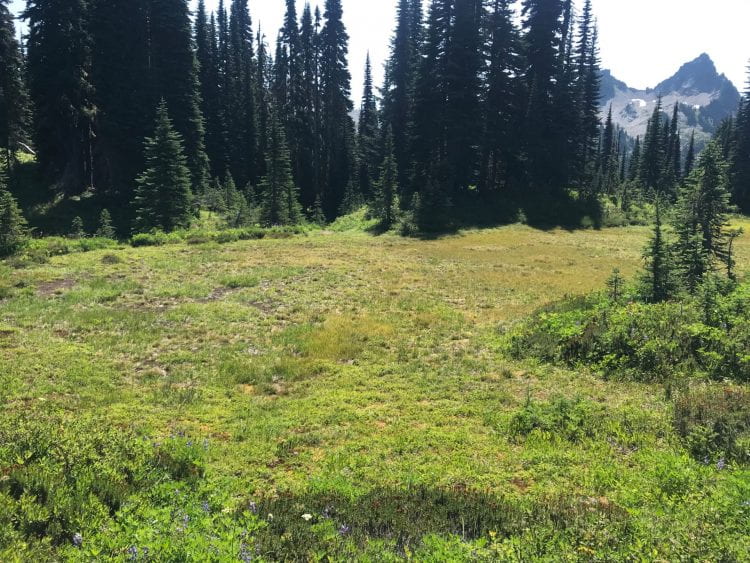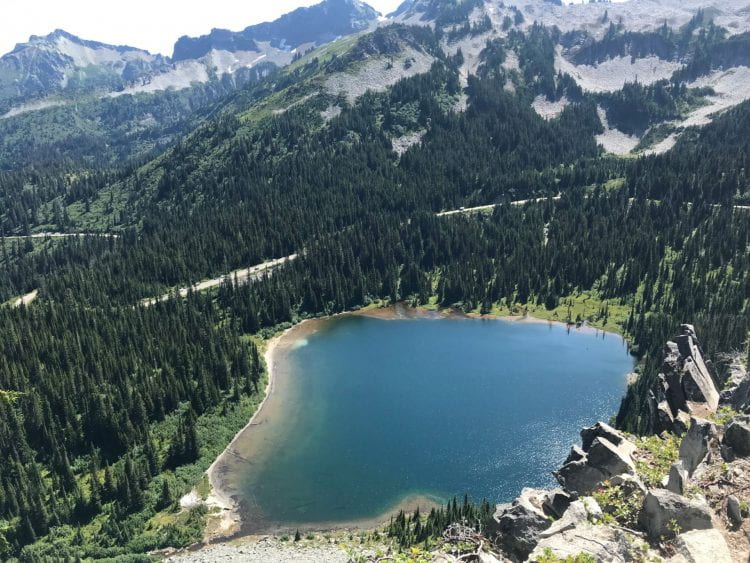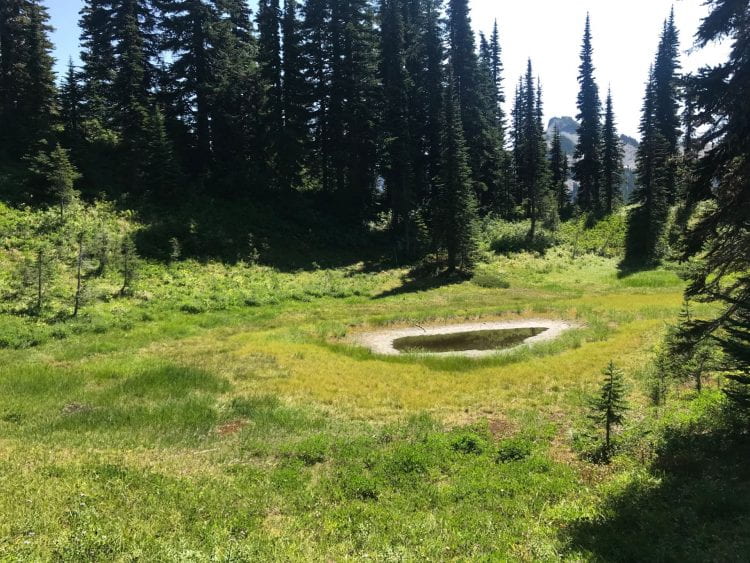August 21, 2019
Ecology Blog 1: Exploring wetlands at Mt. Rainier National Park (Paradise Area)
Hello!We are from the ecology group, our first blog is about wetlands. We finished the blog together and everyone wrote a part of it. First we visited Paradise Visitor Center at Mount Rainier National Park, and learned about social trials from Dr. Monika Moskal. Then Dr. Meghan Halabisky from University of Washington (UW) and Conservations Science Partners (CSP) lead us to a few wetlands and gave us a small lecture near a meadow.
At first, Meghan told us about the common indicators of wetlands in U.S. :
- Hydrology : Whether it is saturated with water for at least two weeks or the topography can imply that.
- Vegetation : Indicator plants around the wetlands.Soil : Wetlands will have a lot of organic materials in its soil.
The ecology group! (Chen Minlan, Zong Xueying, Zhu Wenjing, Wu Shuhan, & Gou Yuancong)
She also talked about some of the functions of wetlands:
- Wetlands along rivers act as buffers when floods come
- Wetlands can hold water and help to keep a balance of water in dryer seasons
- Wetlands are filters to clean water
- Wetlands are homes to many young amphibians and plants (but also a “snack buffet” for other animals)
- Wetlands can help to suppress fire
- Wetlands will play an important role in the response of the whole forest ecosystem to climate change.
Then we began our trip. Our hiking route is shown on the google map below.
First Stop
 The first meadow we visited, this open field does not have water, but it is still considered a wetland. With climate change and some activities of human like overbreeding of livestock, these open areas are becoming drier. As we can see in the picture, when these areas begin to dry out, some trees begin to move in. With the encroachment of the trees, meadows begin to turn into forests. While, forest is one of the ideal types of landcover, for the sake of the diversity of plants and animals, we need to keep meadows in the forests. Meadows in the forests are important places for wild animals for food and reproduction. Meadows move nutrition into the forests through animals and plants. Animals come here to release nutrition by the ways of excretion. It is a critical cycle to connect forests and meadows.
The first meadow we visited, this open field does not have water, but it is still considered a wetland. With climate change and some activities of human like overbreeding of livestock, these open areas are becoming drier. As we can see in the picture, when these areas begin to dry out, some trees begin to move in. With the encroachment of the trees, meadows begin to turn into forests. While, forest is one of the ideal types of landcover, for the sake of the diversity of plants and animals, we need to keep meadows in the forests. Meadows in the forests are important places for wild animals for food and reproduction. Meadows move nutrition into the forests through animals and plants. Animals come here to release nutrition by the ways of excretion. It is a critical cycle to connect forests and meadows.
The second site was a small pond. It was surrounded by dense Douglas Fir. The pond was tiny but fueling a huge potential function for the ecosystem. According to Meghan, this year was a really bad year for wetlands, threatening the lives of tadpoles and frogs.
The presence of water in the middle of the pond impeded the growth of vegetation. However, there were rings of different vegetation around the pond. But why did the vegetation show this kind of distribution? Maybe the discrepancy between different vegetation for hydrological need and the extent and sequence of drought.
Third Stop With the great persistent effort, we finally found another wetland. We were lucky enough to see two salamanders! According to Dr. Halabisky, salamanders are aggressive hunters and thrive in ponds and wetlands. After World War II, people in the USA had held a wrong view towards wetlands. There was a desire to encourage recreation of all the wild area, and lots of non-native fish and plants were imported. Those fish were even more aggressive hunters than the salamanders, which meant that this policy had played a negative role in preserving the biodiversity of the wetlands.
With the great persistent effort, we finally found another wetland. We were lucky enough to see two salamanders! According to Dr. Halabisky, salamanders are aggressive hunters and thrive in ponds and wetlands. After World War II, people in the USA had held a wrong view towards wetlands. There was a desire to encourage recreation of all the wild area, and lots of non-native fish and plants were imported. Those fish were even more aggressive hunters than the salamanders, which meant that this policy had played a negative role in preserving the biodiversity of the wetlands.
Final Lookout Stop
 The last point of our hiking was a lake. How nice it was to see such a glorious scenery after long hiking! Meghan said maybe it was supported by groundwater and has no amphibians in it. The water of the lake was blue and likely had large amounts of copper ions dissolved in it.
The last point of our hiking was a lake. How nice it was to see such a glorious scenery after long hiking! Meghan said maybe it was supported by groundwater and has no amphibians in it. The water of the lake was blue and likely had large amounts of copper ions dissolved in it.
We saw several wetlands and they all seem to have a lot of differences (even the meadows). Some of the wetlands were very small and seemed to change a lot with time. How to monitor these tiny “sly” wetlands? Remote sensing and lidar seem to be good for detecting wetlands, but we are also interested in the mechanism of wetlands formation. What is the most important factor? Topography? Microclimate? If we know the weights of different factors, we can try to predict the changing of the wetlands both spatially and temporally. Then we can compare our results to the real world and see if we have good models. Moreover, if we know how the wetlands are formed and we need more of them, maybe we can make some wetlands in the future and make sure they will stay.




